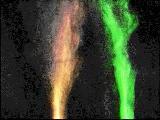My research was
generally focussed around using different methods to estimate the
convective heat loss at the mid-ocean ridge. It has long been
known that hydrothermal circulation effectively cools this
60,000+ km system of volcanism that encircles the globe in the
"middle" of the major ocean basins. There have been
many attempts to measure just how much heat is lost at the
mid-ocean ridge. While these estimates are generally the right
order of magnitude, each method has it's own errors associated
with it, making comparisons between different techniques
difficult.
 The image to the right is a time averaged view
of dye concentration in two buoyant plumes which are coalescing
near the top of the image. This is similar to the way
hydrothermal plumes coalesce above a vent field. Working with my
advisor, Russ McDuff, my goal was to
use a combination of theory, lab observations and field
measurements to develop a reproducible estimate of hydrothermal
venting from a mid-ocean ridge. My Master's project was an
analysis of using acoustic measurements to measure the speed of
sound in the water column above a hydrothermal vent field. Sound
speed is to first order a function of temperature, so this
technique would be an effective way to map the temperature
anomalies associated with hydrothermal venting.
The image to the right is a time averaged view
of dye concentration in two buoyant plumes which are coalescing
near the top of the image. This is similar to the way
hydrothermal plumes coalesce above a vent field. Working with my
advisor, Russ McDuff, my goal was to
use a combination of theory, lab observations and field
measurements to develop a reproducible estimate of hydrothermal
venting from a mid-ocean ridge. My Master's project was an
analysis of using acoustic measurements to measure the speed of
sound in the water column above a hydrothermal vent field. Sound
speed is to first order a function of temperature, so this
technique would be an effective way to map the temperature
anomalies associated with hydrothermal venting.
My other interests are quite varied, ranging from inverse
theory, imaging techniques, computer visualization, spectral
analysis, instrument design, earthquake mechanics and dynamics
(my first love begun at Princeton University), and seismology.
Most of these interests have been sparked by trying to figure out
good ways to measure the heat flux from a hydrothermal vent
field.
Home|Research|Teaching|Travel|About
 The image to the right is a time averaged view
of dye concentration in two buoyant plumes which are coalescing
near the top of the image. This is similar to the way
hydrothermal plumes coalesce above a vent field. Working with my
advisor, Russ McDuff, my goal was to
use a combination of theory, lab observations and field
measurements to develop a reproducible estimate of hydrothermal
venting from a mid-ocean ridge. My Master's project was an
analysis of using acoustic measurements to measure the speed of
sound in the water column above a hydrothermal vent field. Sound
speed is to first order a function of temperature, so this
technique would be an effective way to map the temperature
anomalies associated with hydrothermal venting.
The image to the right is a time averaged view
of dye concentration in two buoyant plumes which are coalescing
near the top of the image. This is similar to the way
hydrothermal plumes coalesce above a vent field. Working with my
advisor, Russ McDuff, my goal was to
use a combination of theory, lab observations and field
measurements to develop a reproducible estimate of hydrothermal
venting from a mid-ocean ridge. My Master's project was an
analysis of using acoustic measurements to measure the speed of
sound in the water column above a hydrothermal vent field. Sound
speed is to first order a function of temperature, so this
technique would be an effective way to map the temperature
anomalies associated with hydrothermal venting.